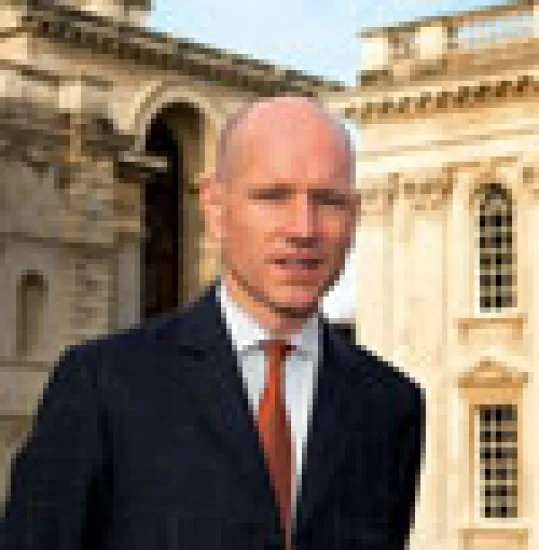In today’s climate even the most innocuous investments can be fraught with risk. But that hasn’t dissuaded Nick Cavalla, the University of Cambridge’s first chief investment officer, from pursuing an ambitious plan to reengineer the largest, most high-profile university endowment in the U.K.
Cavalla, 48, started the job in April 2007, when credit was plentiful, equity markets were rising, and the world’s economy was growing at a robust 5 percent. The global financial picture has since deteriorated dramatically, prompting mass bank nationalizations and setting off a recession in much of the industrialized world. As a result, Cavalla plans to make his changes slowly and with extreme caution — notably, putting the brakes on a move into hedge funds — but the former hedge fund executive is still committed to diversifying the portfolio. “We have been stealthily building our allocations to alternatives,” Cavalla tells Institutional Investor in his first interview since stepping into the role, “but we have had to reassess those targets in light of the financial crisis, because we’re now watching economic history being made.”
In a global crisis nothing can be taken for granted. Just last month Cambridge’s treasury team — which oversees the university’s cash deposits — discovered that it had £11 million ($18 million) frozen in money market funds in Iceland after the country’s banking system collapsed. Although the loss didn’t affect the endowment, Cavalla notes dryly that in the new world order, hidden risks can lurk anywhere.
Previously, Cavalla spent ten years as CIO of Man Global Strategies, one of the three multimanager alternative investment divisions within Man Investments, a part of U.K. fund-of-hedge-funds giant Man Group. At Man, Cavalla was responsible for overseeing the teams that researched alternative investment managers and monitored their performance and allocations — skills that should serve him well as he recruits new managers for Cambridge’s endowment.
Despite the chaos and uncertainty roiling the global markets, Cavalla has been working with Cambridge’s investment committee — an all-star group that includes Michael Dobson, chief executive of U.K. asset management giant Schroders, and David Swensen, chief investment officer of Yale University’s $22.5 billion endowment — to set new allocation targets for the university’s £1 billion endowment. (It’s a paltry sum by the multibillion-dollar standards of many U.S. university endowments, but very few British universities are wealthy. Rival University of Oxford has a core endowment of just £680 million.)
The Oxbridge endowment pools were traditionally managed by committee and heavily invested in public traded equities and real estate, but the volatility of those portfolios — coupled with the universities’ ongoing budgetary requirements — made for a poor fiscal match. Starting three years ago, both Cambridge and Oxford sought to radically overhaul their approach to endowment management to try to make more money, like their U.S. rivals Harvard University and Yale.
With his handpicked team of three investment professionals (he plans to hire two more), Cavalla is reshaping the portfolio’s investment profile, moving out of publicly traded equities, where 70 percent of the fund’s assets have largely been invested with one external manager, London-based F&C Investments, and putting money to work in a broader range of securities and strategies, including hedge funds, private equity and real assets, such as commodities and natural resources. He is also slowly reducing the portfolio’s 15 percent allocations to both real estate and fixed income, which includes cash.
The most trying aspect of his job, Cavalla says, is determining whether an investment strategy developed before the credit crisis will continue to be relevant if the global economy slides into a prolonged recession. But he remains determined. Cavalla plans to reduce the long-only portion of the overall endowment to about 40 percent, allocate 23 percent of the portfolio to real assets (with property constituting 10 percent of that total), put 20 percent into hedge funds (although he may not allocate that much, given the lousy performance of most funds in the industry, which were down 10 percent, on average, through September), deploy 9 percent to private equity funds and leave 8 percent in fixed income and cash. He discussed his strategy in a recent interview.
Institutional Investor: Did you reassess Cambridge’s allocation targets in light of the global economic slowdown?
Cavalla: Yes, we revisit our targets every year, but so far we’ve left them unchanged because these are very long-term targets. The strategy has been to build our alternatives portfolio in three areas: hedge funds, private equity and real assets. We’re still in the process of traveling toward our new targets, so we have some distance to go. We’ve made investments in just seven hedge funds to date, for example, but we’ve decided to stop further hedge fund investing for the moment because the industry as a whole is undergoing quite a meltdown. We have made two private equity investments in the past few months, but we need to make sure that we don’t overemphasize alternatives in a world in which the more obvious opportunities become undervalued traditional equity and bond investments. If the market rout continues, global equities markets may become relatively attractive.
You’ve been actively dialing down Cambridge’s exposure to long-only equity investments. Are those proceeds going directly into alternative strategies?
Some of the proceeds are, but we have also used them to reshape the long-only equity portfolio itself. We’ve now focused it on a global, rather than a U.K., benchmark and have been actively developing new manager relationships — looking for managers who have a very clear philosophy about their alpha generation and can demonstrate to us where they’ve made excess returns. These managers are likely to be running boutique investment firms, or smaller groups, where there is a distinctive style and, typically, a more concentrated set of positions than we would get with a large asset management house. By making those new allocations, we have effectively removed the sterling bias that the endowment had.
Do you have any concerns about the endowment’s relatively large exposure to U.K. real estate?
We have actually reduced our exposure to property this year, taken it down to just 10 percent, but we still think it’s a pretty secure set of assets in the long run. Will we have some voids in our commercial properties and experience some rent impairment? Yes. But property is still very useful, if you think about it as a real asset allocation, for its inflation-linked characteristics.
Do you have any other inflation-linked asset allocations, given that U.K. inflation is running at more than 5 percent?
We have a small exposure to index-linked government bonds, but that’s about it right now. We have spent a lot of time thinking about commodities and real assets, though, which are arguably much more attractively priced right now than they were six months ago. Rather than looking to buy commodity index exposure, we decided that it would be smarter to look for alpha-generating managers in those categories, so we’re about to bring a real-asset investment specialist onto the team.
You’ve said that you want to allocate 20 percent of the portfolio to hedge funds. Have you slowed down those allocations in light of the poor performance across the industry?
Yes, we’ve stopped funding new relationships for the moment. Our plan has been to invest 1 percent of the portfolio with [each of] 20 managers, but we will review that target toward the end of the year. We’re happy with the seven managers that we do have, and this is no time to make fresh allocations. By early 2009 it will become more apparent who will be the winners and losers in what is proving to be a period of structural, rather than cyclical, change for the hedge fund industry. We had anticipated being overweight credit and distressed strategies, and I think that will still be true, but we need to see what happens to the industry.
Does the wide dispersion of returns this year make it any easier to find strong managers?
Yes, in the sense that you can see how well they’re able to invest under adverse conditions. But the greater concern I have is what happens over the next couple of years, given the head winds that managers face: Financing is hard to get and very expensive, borrowing stocks to short is tough, and investors — many of whom have been disappointed with their managers’ performance — will likely pull their money. Against that back-drop, though, a culling of the industry will reduce the crowding so evident in today’s markets as managers search for alpha.
Has the financial crisis affected the way you and your team perform due diligence on prospective hedge fund managers?
Yes, we’ve been even more focused on their counterparty risks — where they’re getting their financing and how it’s being provided. We are also very concerned about liquidity: We don’t want to buy into a portfolio that is illiquid and misvalued, so we are leery of anyone with hard-to-value investments on their books that have not been sidepocketed away from the main fund.
Cambridge has very little exposure to private equity — is that an advantage, now that the leveraged buyout market has effectively dried up?
Let’s just say it’s not a bad time to be underinvested in private equity. That said, we recently hired Nick Shaw from Gartmore, where he was deputy managing director of private equity investments, and he’s going to help us look at possible stakes. But we’re not expecting to do much in the near term; if anything, we’ve been focused on finding attractive, sensible ways to fill out this allocation — such as using quoted private equity and looking at the secondary market.
How difficult is it to be actively investing in an economic environment where nothing — not even a cash deposit — can be considered safe?
It’s obviously not easy for any endowment fund, including ours, because the global market has become more alarmingly erratic, and, depending on who you read, even apocalyptic. We have to be constantly vigilant and prepared to reconsider all of our assumptions.
THE FACTS
NAME: Nick Cavalla
POSITION: Chief investment officer, the University of Cambridge
APPOINTMENT: November 2006
WHAT WE KNOW: He is working to mitigate the volatility of the endowment portfolio and deliver better risk-adjusted returns for the university, which celebrates its 800th anniversary next year.






